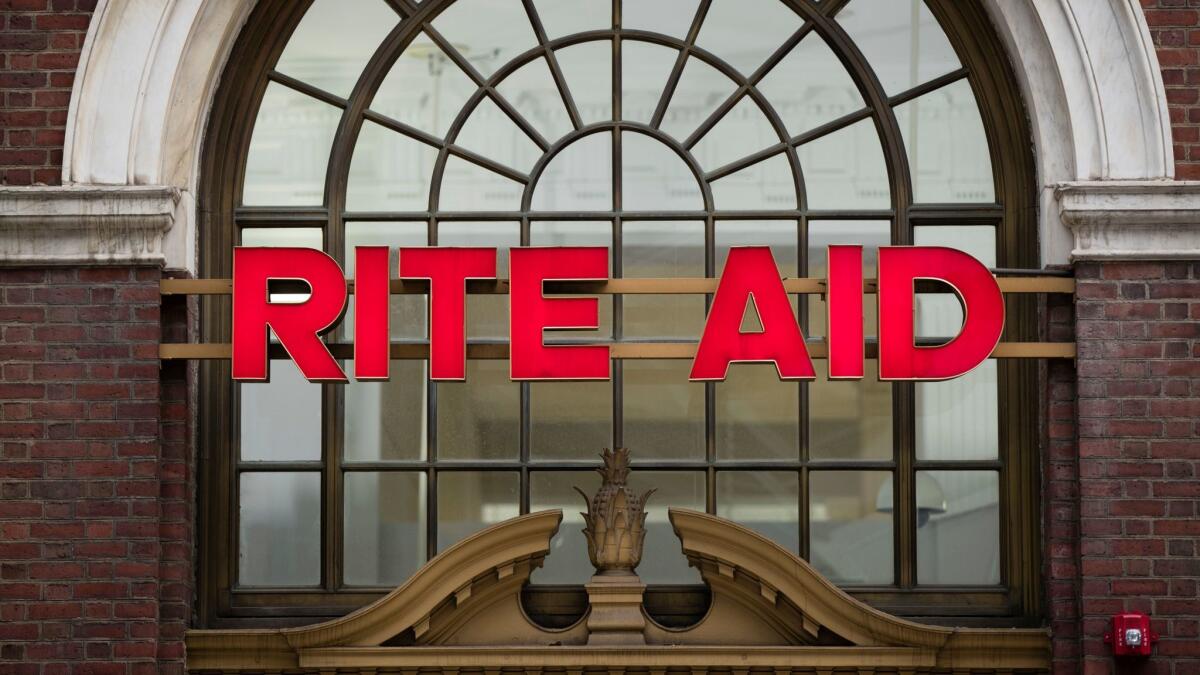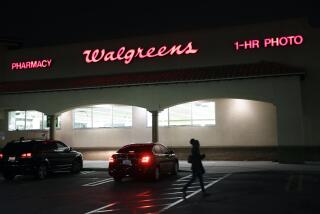Albertsons, which owns grocers Vons and Safeway, is buying Rite Aid

Grocery operator Albertsons Cos. plans to buy drugstore chain Rite Aid Corp. — a move it announced Tuesday as major retailers continue to bulk up and diversify in the face of shifting consumer shopping trends and stiff competition from retail giants Amazon.com Inc. and Walmart Inc.
The deal also would clear the way for closely held Albertsons to become a public concern whose shares trade on the New York Stock Exchange, the companies said.
Albertsons — which operates the grocery chains Vons, Pavilions and Safeway as well as its namesake grocery stores — said it’s acquiring the part of Rite Aid that isn’t being sold to Walgreens Boots Alliance Inc. under a previously announced deal. Albertsons would get slightly more than half of Rite Aid’s retail locations, plus additional Rite Aid assets such as its pharmacy benefit company and its wellness/loyalty program.
Rite Aid stockholders would receive either Albertsons stock or a combination of Albertsons stock and cash. The value of the deal wasn’t disclosed, but Rite Aid has a current stock market value of $2.3 billion.
The combined company would have 4,900 locations, including 4,350 pharmacies and 320 clinics in 38 states and Washington, D.C., and annual revenue of $83 billion.
Albertsons currently has 2,323 stores, including 608 in California, its largest market. The Boise, Idaho, company already operates more than 1,700 in-store pharmacies through its various subsidiaries, which also include the Jewel-Osco chain.
Rite Aid, headquartered in Camp Hill, Pa., has 2,569 locations, including 576 in California, that are not part of the Walgreens deal and that would be folded into Albertsons.
The merger “will create a leader in food, health and wellness,” Albertsons Chief Executive Robert Miller told analysts on a conference call Tuesday. “This is a combination that is going to create a lot of value and numerous opportunities for growth.”
All three of the nation’s largest drugstore chains are involved in deals to expand in the face of grocery and pharmacy competition from mass merchants Walmart and Target Corp., and amid speculation that e-commerce giant Amazon is looking to enter the pharmacy business.
Amazon staked a claim in the grocery business last year by acquiring Whole Foods Market Inc. for $13.7 billion. That deal put added pressure on Albertsons and other rivals to keep prices down at a time when grocers already are feeling pinched by price pressures and eking out tiny profits.
Partly in response to the prospect of Amazon entering the pharmacy sector as well, the nation’s largest drugstore chain, CVS Health Corp., in December agreed to buy health insurer Aetna Inc. for $69 billion.
The second-largest drugstore chain, Walgreens, originally tried to buy all of Rite Aid. After being stymied by antitrust regulators, Walgreens agreed to acquire nearly 2,000 of Rite Aid’s stores for $4.4 billion.
Albertsons and Rite Aid said that they would maintain dual headquarters in Boise and Camp Hill, and that Rite Aid CEO John Standley would become chief executive of the combined company while Miller would be chairman. The name of the combined company has yet to be determined.
The deal calls for Rite Aid stockholders to receive either one Albertsons share and $1.83 in cash, or 1.079 Albertsons shares, for every 10 shares of Rite Aid stock they own. Albertsons currently is owned by an investment group led by Cerberus Capital Management.
Rite Aid’s stock rose 7 cents, or 3.3%, to $2.20 a share Tuesday. The stock has tumbled from about $6 a share a year ago.
Albertsons and Rite Aid said that their deal remains subject to approval by regulators and Rite Aid shareholders, and that it is expected to be completed in the second half of this year.
The combined company probably would be able to negotiate better prices from manufacturers of pharmacy products, and it plans to eliminate $375 million of operating costs within three years.
Both goals are key reasons behind the acquisition, said Joe Agnese, an analyst with CFRA Research.
“The companies are operating in a difficult environment where scale is important to try to reduce costs” for added growth and to maintain profits, not only because of price competition from Walmart and others, but also because of insurers lowering the prices they’re willing to repay pharmacies when insured customers fill prescriptions, Agnese said.
Albertsons and Rite Aid also have “significant geographic overlap” on the West and East coasts, which could help lower the combined company’s costs of distributing its private-label products, he said.
“One truck can make deliveries to a local Rite Aid drugstore and an Albertsons supermarket,” Agnese said.
Diana Sheehan, director of research and insights at Kantar Consulting, said the merger could help Albertsons and Rite Aid because it “brings together two retailers that have struggled to thrive in a highly competitive retail landscape independently.”
Indeed, Albertsons and Rite Aid each reported that same-store sales — that is, sales at stores open at least a year — were down in their fiscal third quarters, which ended in early December.
But, Sheehan cautioned, CVS and Walgreens — not Rite Aid — are the reigning drugstore chains in almost all of Albertsons’ core markets. As Albertsons looks to rebrand the in-store pharmacies it already has, she said in an email, it “would need to build demand for the Rite Aid brand name.”
Albertsons could do that by integrating Rite Aid into its network of stores, said William Conaboy Jr., a healthcare attorney with the law firm Buchanan Ingersoll & Rooney.
“There’s plenty of room for competition to reach folks who want speed,” he said. “You can get your groceries, get your medication and get some counseling from your neighborhood pharmacist and get it all done in one shot.
“I don’t think it’s just going to be a grocery store that has a pharmacy stuffed into the back corner.”
Twitter: @PeltzLATimes
UPDATES:
3:20 p.m.: This article was updated with more details about the effect on grocers of Amazon’s purchase of Whole Foods.
2:25 p.m.: This article was updated with Rite Aid’s closing stock price and additional analyst comment.
12:55 p.m.: This article was updated with analysts’ comments about the rationale behind the deal.
10 a.m.: This article was updated throughout with Los Angeles Times staff reporting and background information about the companies’ California presence, the competition they face, and other mergers and acquisitions involving drugstore and grocery chains.
This article was originally published at 5:55 a.m.
More to Read
Inside the business of entertainment
The Wide Shot brings you news, analysis and insights on everything from streaming wars to production — and what it all means for the future.
You may occasionally receive promotional content from the Los Angeles Times.










